Hazards to Avoid in Florida
We want you to have a safe and fun experience while fishing in Florida, so please read about common local Hazards to Avoid, many of which you may not be aware of.
Heat and Sunburns
Heat related injuries such as severe sunburns, dehydration, and even heat stoke can occur any time of the year in Florida. Summer heat and humidity can be oppressive. In the winter, the sun is still strong enough to cause severe sunburns. It is also advised to always wear sunglasses to protect your eyes from strong UV rays.
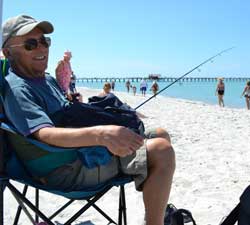 Avoid dehydration by drinking plenty of water. Most doctors recommend drinking at least one gallon of water or electrolyte beverages per day while involved in outdoor activities. Don't wait to drink until you feel thirsty as at that point you may already be dehydrated. Drinking sugary, alcoholic or caffeinated drinks actually dehydrates you, water is your best bet. Another great tip is to eat watermelon when you fear you have heat stroke.
Avoid dehydration by drinking plenty of water. Most doctors recommend drinking at least one gallon of water or electrolyte beverages per day while involved in outdoor activities. Don't wait to drink until you feel thirsty as at that point you may already be dehydrated. Drinking sugary, alcoholic or caffeinated drinks actually dehydrates you, water is your best bet. Another great tip is to eat watermelon when you fear you have heat stroke.
Beach sand, especially the sugar white sands of southern Florida, reflect the sun very strongly. Occasionally getting out of the sun helps to reduce heat exhaustion and sunburns. When on the beach, use a beach umbrella to get out of the sun periodically. Many anglers bring umbrella's to keep their live bait cool and offer them an escape from the sun. Wearing a hat (wide brimmed is best) and light weight long sleeve shirts and pants help to protect you from sunburn. 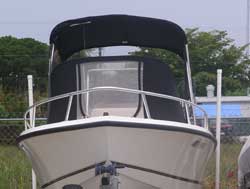
As you may notice, most boats have Bimini covers where you can escape our strong sun. A dodger as shown on the boat to the right also provides escape from the sun and is wonderful if you get caught in a storm.
ALWAYS wear sunscreen, even in the winter months you can get severely burned if you are out in the sun too long. If you are on the beach under an umbrella, the sun reflecting off the sand can still burn you.
Float Plans
Float Plans not often used by locals or visitors alike. They are important for your safety and your families peace of mind. All too often we hear new reports of vehicles with trailers left at the launch site and the boater nowhere to be found. Families worry if you don't return when expected. If you get lost, your boat breaks down, etc. at least someone on land will know your are missing if your don't return by your expected arrival time and send for help. This is one habit all boaters should get into especially if you go out on the water alone.
Always leave a Float Plan at home, with a trusted person, in your vehicle at your launch site, and at a park ranger station if you venture out from a park. In your float plan identify all people and animals in your party, your parked vehicles, trailer, kayaks and boat, your planned route, date of return and if you plan on camping, where you plan to camp. Also leave a copy of your float plan with a friend back at home. We have a float plan available for printing, click here for our Float Plan.
Getting Lost
Most backwaters are largely uninhabited, meaning help is not always immediately available. Cell phone service is limited, unreliable, and mostly nonexistent in the backwaters so having a GPS or nautical map and compass AND a VHF radio is important. Every inlet and channel looks the same so it's easy to get lost. We have few tall landmarks to help guide your way.
A GPS is always best because if you get lost you can report your exact location, otherwise trying to find you is like finding a needle in a haystack?there are literally over 10,000 islands here.
Beaching Your Boat & Boat Groundings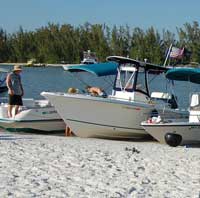
Beaching your boat can also happen if you don't watch the tides when you pull your boat up to the beach. When visiting our out islands and beaching your boat, always keep an eye on the tide and especially the back of your boat to be sure the motor is still in the water so you can pull yourself off. Periodically repositioning your boat on the beach is the best preventative measure your can take. If you find yourself "high and dry" don't try to pull your boat off or you can damage it, wait for the tide to return is your best option.
Many waterways are very shallow, especially on the Gulf side of the state and the Keys, and running aground is a common occurrence even for experienced locals.
During low tides and especially low moon tides, our inshore waterways are VERY shallow, even inside navigational markers. Knowing the "depth" of the water is very important as you travel on our waterways. Use an up to date nautical chart, your boat's depth finder, and your eyes to guide you.
 Staying inside the channel markers is advised, but not always reliable to avoid grounding. Just last month I ran aground with my small 17' Mako almost near the entrance to Marco River on the Gulf side inside the channel marker. And to make matters worse, the marine patrol saw me, came to investigate and ran aground too. This did not stop him from performing an inspection on my boat!
Staying inside the channel markers is advised, but not always reliable to avoid grounding. Just last month I ran aground with my small 17' Mako almost near the entrance to Marco River on the Gulf side inside the channel marker. And to make matters worse, the marine patrol saw me, came to investigate and ran aground too. This did not stop him from performing an inspection on my boat!
Another common occurrence is to see a boater come flying into a wide bay and obviously not knowing the local waters run straight down the middle, right into a sand bar. The sudden stop throws everyone off their feet and grounds the boat hard. The current in most bays run along the sides of the bay, so usually the middles off bays have sandbars. Never ever fly down the middle of a bay unless you know the waters.
Running aground can also damage fragile seagrass and marine life, throw passengers from your boat from the sudden stop, and can damage your boat. Here are some great tips to help you have a safe trip. If you get caught damaging sea grass there is a $1,000 fine.
Learn to Read the Water
- Brown, Brown, Run Aground. Avoid brown areas! This water color indicates that reef formations or seagrass beds are close to the surface.
- White, White, You Just Might. Use caution! Sand bars and rubble areas may be much shallower than they appear.
- Green, Green, Nice and Clean. Green waters are generally safe for shallow draft boats, larger, deeper draft vessels should exercise caution.
- Blue, Blue, Cruise On Through. Clear sailing in deep water areas.
Oh No! What Do I Do If I Ran Aground?
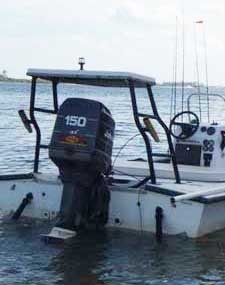 Always stop immediately! Attempting to power off can cause significant damage to your vessel and to the living bottom communities. If you do run aground or if you venture into shallow water and start stirring up mud in your wake, Stop!
Always stop immediately! Attempting to power off can cause significant damage to your vessel and to the living bottom communities. If you do run aground or if you venture into shallow water and start stirring up mud in your wake, Stop!
- Trim your motor up and try going slowly in reverse.
- Try to push or pole your boat off, following the route in (back up).
- If you are stuck hard, turn your motor off. Do not attempt to power forward.
- Trim your motor up. Get all passengers off the boat (except the captain) and float off.
- Wait for high tide in order to drift off.
- Call for commercial assistance on VHF channel 16.
Another tip a friend told me that I will try the next time I hit shallow water (yes, next time) is to take your anchor and toss it towards deeper water and slowly pull your boat. It helps to get everyone except the captain off the boat to raise it in the water. Check out our Tides and Nautical Charts page for more information.
Red Tide
 Red Tide usually occurs in the summer months in the Gulf of Mexico. When red tide is present, large fish kills occur with dead fish littering the beaches. Red Tide is a large algae bloom that occurs offshore. Red Tide is especially dangerous for people with asthma and respiratory problems. Symptoms are red, stinging eyes and a burning, hacking, dry cough. If you swim in water with the Red Tide algae present you may experience itchy skin. If you start coughing when you walk up on the beach, red tide may be present. You will usually hear Red Tide is in our waters on the news. There are Red Tide Hotlines available around Florida, check your local phone directory for the number in your area. There is also a Aquatic Toxins toll free hot line at 1-888-232-8635 if you get sick.
Red Tide usually occurs in the summer months in the Gulf of Mexico. When red tide is present, large fish kills occur with dead fish littering the beaches. Red Tide is a large algae bloom that occurs offshore. Red Tide is especially dangerous for people with asthma and respiratory problems. Symptoms are red, stinging eyes and a burning, hacking, dry cough. If you swim in water with the Red Tide algae present you may experience itchy skin. If you start coughing when you walk up on the beach, red tide may be present. You will usually hear Red Tide is in our waters on the news. There are Red Tide Hotlines available around Florida, check your local phone directory for the number in your area. There is also a Aquatic Toxins toll free hot line at 1-888-232-8635 if you get sick.
Do not eat filter feeding mollusks (clams or oysters) taken from Florida red tide waters); fish, crabs, lobsters, and shrimp are not affected if they are healthy. Do not eat a distressed or dead fish as they may be poisoned by the red tide.
For more information visit FWC's Red Tide page.
Beach Flag Warning System
Florida has a Beach Flag Warning System to alert beach goes of the current conditions and if hazards are present on our beaches. The absence of flags does not guarantee safe waters.
Florida's beach warning flag program uses flags in four colors accompanied by interpretive signs along the beach to explain the meaning of each color.
- GREEN: LOW HAZARD - Calm Condition, Exercise Caution
- YELLOW: MEDIUM HAZARD - Moderate Surf and/or Moderate Currents
- RED: HIGH HAZARD - High Surf and/or Strong Currents
- DOUBLE RED: WATER CLOSED TO PUBLIC
- PURPLE: Marine Pests Present
Rip Currents can occur and are not visible from the beach. These currents are especially dangerous because they can sweep you away. Rip currents can extend 1,000 feet offshore, reach 100 feet in width and travel up to 3 mph. You can sometimes tell a rip current is present by the difference in the water to it's surroundings, like a calm spot in the middle of the water. If you get caught in a rip current, don't panic or swim against the current; swim parallel to shore until you are out of the current.
Extreme Weather
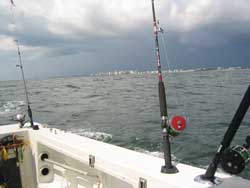 Don't be disillusioned by our beautiful weather, Florida is the lightning capital of the world with violently powerful lightning storms that are spectacular. More deaths occur from strikes in Florida than anywhere, with June through August being the peak months. Weather fronts can come upon you quickly and without much warning.
Don't be disillusioned by our beautiful weather, Florida is the lightning capital of the world with violently powerful lightning storms that are spectacular. More deaths occur from strikes in Florida than anywhere, with June through August being the peak months. Weather fronts can come upon you quickly and without much warning.
The Gulf of Mexico is view by visitors to our state as a bath tub, but when the weather kicks up it can turn into a wash tub fast. A 20 foot sea in the Gulf is much more dangerous than a 20 foot sea in the Atlantic because the waves get much steeper and are much closer together. One day traveling south from Fort Myers to Naples on a 28' boat the Gulf suddenly errupted in 6 foot waves. We spent 2 hours looking at the Ritz Carlton in Naples trying to travel south, not getting anywhere until suddenly the Gulf calmed and released it's grip on us.
Thunderstorms are especially dangerous on the water and be down right scarey in Naples. Not only do thunderstorms bring lightning, they bring high winds and torrential rain. Because of our shallow waters, incoming fronts can transform a quiet bay into a choppy dangerous waterway in a matter of minutes. Always check the Weather before departing.
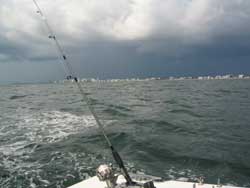 One day I was in the 10,000 islands south of Goodland at Coon Key and could see black sky in the distance and determined the wind was coming my way. My passenger said "it is so far away, don't worry we can get back to Goodland in time". With many years experience on these waters, I ignored my passengers advise and rushed to find an inlet behind an island to secure the boat. I grabbed my second anchor, walked into the water and planted the anchor. Then I used my main anchor and planted it on the island. I barely had enough time to do this and the storm was on us. We scrunched down behind my center console, put a towel over our heads, and endured the worst storm I have ever encountered outdoors. The wind was in the 40-50 mph range with cold torrential rain and huge thunder bolts. The water turned in to a washing machine with 4 foot waves! Even with double anchors my boat was pushed into the mangroves out of the water damaging my nav light. The storm was scarey and only lasted 5 minutes, but if we didn't anchor up we would have been in serious trouble in open water. Take my advise and seek shelter fast if a storm is approaching.
One day I was in the 10,000 islands south of Goodland at Coon Key and could see black sky in the distance and determined the wind was coming my way. My passenger said "it is so far away, don't worry we can get back to Goodland in time". With many years experience on these waters, I ignored my passengers advise and rushed to find an inlet behind an island to secure the boat. I grabbed my second anchor, walked into the water and planted the anchor. Then I used my main anchor and planted it on the island. I barely had enough time to do this and the storm was on us. We scrunched down behind my center console, put a towel over our heads, and endured the worst storm I have ever encountered outdoors. The wind was in the 40-50 mph range with cold torrential rain and huge thunder bolts. The water turned in to a washing machine with 4 foot waves! Even with double anchors my boat was pushed into the mangroves out of the water damaging my nav light. The storm was scarey and only lasted 5 minutes, but if we didn't anchor up we would have been in serious trouble in open water. Take my advise and seek shelter fast if a storm is approaching.
Consider scheduling your trip to avoid storms?in the summer storms usually occur after 2:00 PM daily. Always get out of the water when swimming or boating if thunder and lightning is present and seek shelter. If you are in a vehicle, close the windows tight, small lightning bolts crackling in the air can strike you inside your car.
Keeping your marine radio set to NOAA's Marine Radio VHF channel 22A, especially during the summer months. Watch the sky for dark cloud massed approaching. If you see a distant storm, consider the direction of the wind to help you judge where the storm is going. If a storm is coming your way, seek cover immediately. There is no lightning proof boat, so get off and out of the boat if a storm is upon you.
Hurricane Season
 We have severe storms during Hurricane Season which can be a concern for boat owners. Hurricane Season in the Atlantic begins June 1st and ends November 30th, with August the most active month.
We have severe storms during Hurricane Season which can be a concern for boat owners. Hurricane Season in the Atlantic begins June 1st and ends November 30th, with August the most active month.
Hurricanes are common and especially dangerous in Florida due to our very flat landscape. The picture here was taken of the TV screen as Hurricane Charlie was approaching our area in 2004. The worst Hurricane to hit our area in recent years was Wilma in 2005 with top wind speeds of over 150 miles per hour recorded on Isles of Capri. We take hurricanes very seriously here and evacuate when told.
The National Weather Service (NOAA) is our main source for weather. Any warnings issued by NOAA should be taken seriously. If you are ordered to evacuate, do so. If the forecast for the day is for severe thunderstorms, plan your fishing trip accordingly.
When you leave for the season or extended period of time during hurricane season, be sure you boat is tied to the lift and dock securely. Adding boat whips to your dock also helps to keep your boat safely away from the dock during rough weather. If you will be securing your boat and have little experience doing so, recruit an experienced boater or call your local fire station for help. Always have a plan which includes someone in Naples that can check on your boat. A great option is to use a dry storage facility to store your boat during your extended absence from the area.
Mercury in Fish
Mercury can be found in fish anywhere. Low levels of mercury in fish are common and occur in most fish. Mercury is found in fish because it enters the food chain through organisms in the sediment.
Our waters are exceptionally clean and most game fish are OK to eat in moderation. Some fish contain more mercury than others, so always check to be sure the fish you are about to eat is safe. Pregnant woman, children, and the elderly are especially sensitive to the effects of mercury in fish. Check the website Florida Department of Health for information on mercury in our fish and safety precautions. You can also click here for the Fish Advisory PDF file.
Mercury concentrations in game fish from in the Everglades region are some of the highest observed anywhere in the world, especially in the Largemouth Bass populations. If you would like the technical details on this, check out the USGS study Mercury Studies in the Florida Everglades.
|
|---|
Manatees
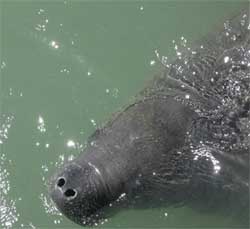 The endangered Manatee is a huge marine mammal located in our slow-moving rivers, shallow estuaries, and salt water bays.
The endangered Manatee is a huge marine mammal located in our slow-moving rivers, shallow estuaries, and salt water bays. 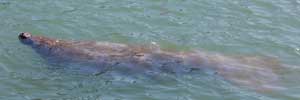 This very gentle mammal is very slow moving and usually can be found in small groups. During the summer they are located throughout our waterways; in the winter they travel inland for warmer waters. It is not hard to spot them, they are generally at the surface, they weight over a thousand pounds and are usually over 10 feet long. They come up for air and you can usually hear the "snort" when they surface. You will also see large flat smooth rings or pools on the surface of the water indicating they are just below the surface.
This very gentle mammal is very slow moving and usually can be found in small groups. During the summer they are located throughout our waterways; in the winter they travel inland for warmer waters. It is not hard to spot them, they are generally at the surface, they weight over a thousand pounds and are usually over 10 feet long. They come up for air and you can usually hear the "snort" when they surface. You will also see large flat smooth rings or pools on the surface of the water indicating they are just below the surface.
We have No Wake Zones and Manatee Zones clearly marked on our waterways. Please observe these speed zones and always be on the look out for these very gentle creatures. Each year manatees are harmed by boat propellers as boats unknowingly skid over them.
Pelicans
 Pelicans are found everywhere near the shoreline and often get hooked by anglers. These huge birds have become a custom to humans feeding them and will generally hang around your boat, docks, or piers waiting for a free meal. Please do not feed the birds and if they are lingering around your fishing spot, move to another one to avoid hooking these beautiful birds.
Pelicans are found everywhere near the shoreline and often get hooked by anglers. These huge birds have become a custom to humans feeding them and will generally hang around your boat, docks, or piers waiting for a free meal. Please do not feed the birds and if they are lingering around your fishing spot, move to another one to avoid hooking these beautiful birds.
On most public piers there are huge Net Rings available to rescue Pelicans that have been hooked. We have photo's of an actual Pelican rescue at Naples Pier on our page How to Rescue a Pelican with a video on How to help reduce Pelican injuries. Check out the Rescuing Hooked Pelicans PDF file on what to do if you hook a Pelican.
Dolphins
Dolphins are everywhere in our coastal waters. They are usually in groups playing and feeding. We see dolphins all the time with damaged fins from boat motors. Many boaters will drive up to a group and not realize they are driving over one of these very large mammals. If you are very close to a group of dolphins, put your boat's motor in neutral and coast over them?better yet, trim up your outboard motor so you don't hit them.
Unexpected Visitors on Your Boat
Boating on our waters is a lot of fun, but sometimes an unexpected visitor may suddenly and unexpectedly land in your boat. This can happen anywhere at anytime. Dolphins, Stingrays, Barracuda's, Sharks, or any other kind of fish that can jump out of the water can land in your boat.
Read our great article on Unexpected Visitors on Your Boat and find out how common it is and what species can land in your boat.
Mosquitoes & No See Ums
 Mosquitoes and biting flies are severe during the hot, humid summer months, but can be present year-round in the Everglades. There are 68 species of mosquitoes in Florida and 43 different mosquito species exist in Everglades National Park, 13 of which bite people. The most common encountered by anglers is the small black Salt Marsh Mosquito. Most counties actively spray for mosquitoes in residential areas, but out in the Everglades they can be a nuisance.
Mosquitoes and biting flies are severe during the hot, humid summer months, but can be present year-round in the Everglades. There are 68 species of mosquitoes in Florida and 43 different mosquito species exist in Everglades National Park, 13 of which bite people. The most common encountered by anglers is the small black Salt Marsh Mosquito. Most counties actively spray for mosquitoes in residential areas, but out in the Everglades they can be a nuisance.
No See Um's are very small, hard to see insects that swarm and nibble on your skin. Sunrise and sunset are the peak activity times for these annoying creatures. They make special screening for your lanai and house windows to keep these insects out.
Insect repellents work well and should always be in your tackle box when fishing. Other precautions include wearing long sleeved clothing that loosely covers your skin (these also protect you from the sun), mosquito net jackets work well too. Avoid thick vegetation, tall grassy areas, and shady areas. When entering and exiting shelter always close doors quickly. Boating and canoeing in open waters helps to avoid mosquitoes.
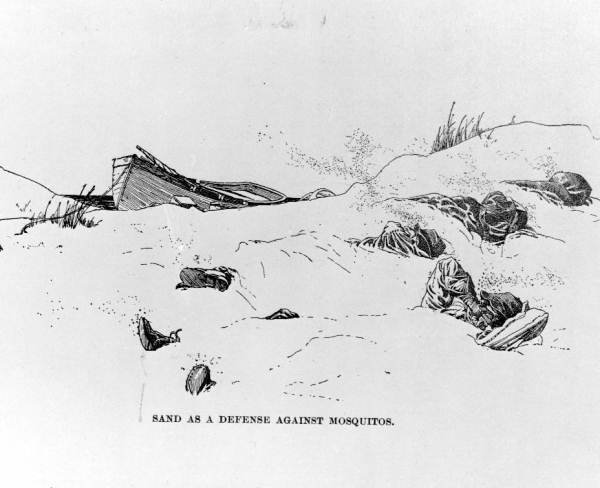
Sand as a defense against mosquitos in the 1860's. Source: http://www.floridamemory.com/items/show/28510
Alligators & Crocodiles
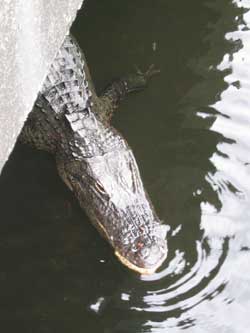 Alligators are everywhere in the freshwaters of Florida and sometimes travel into brackish and saltwater. Remember, these animals that reach over 10 feet long have big teeth, are wild, fierce, and can run 40 miles per hour. Stay clear of alligators and do not provoke them, they will come after you and in an instant they can bit off a limb or even kill you.
Alligators are everywhere in the freshwaters of Florida and sometimes travel into brackish and saltwater. Remember, these animals that reach over 10 feet long have big teeth, are wild, fierce, and can run 40 miles per hour. Stay clear of alligators and do not provoke them, they will come after you and in an instant they can bit off a limb or even kill you.
Crocodiles are more dangerous than alligators. They are rarely encountered but do inhabit Florida's coastal mangrove swamps, brackish and salt-water bays (including northern Florida Bay), creeks, and coastal canals. 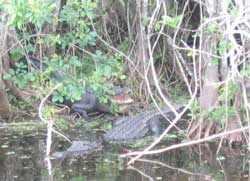
In South West Florida, the canals along US 41 are where you will almost always see alligators. Look along the far side of the banks as you drive US 41 and you will surely see an alligator. The further east you travel on US 41 in Collier towards Miami, the more you will see. There are also two retention ponds in front of the Oasis Visitor Center in Big Cypress National Preserve that are chock full of alligators.
Snakes
 There are 50 species of snakes are found in Florida, with only 6 listed as venomous and a danger to humans. Water Moccasins are in our freshwater ways, are venomous and can be very aggressive so stay clear of them. The Water Moccasin possesses a toxin that brings about painful swelling, and a bite from it does have the ability to kill you. Although most snakes will run when encountering a human, there are times when they can be scarey.
There are 50 species of snakes are found in Florida, with only 6 listed as venomous and a danger to humans. Water Moccasins are in our freshwater ways, are venomous and can be very aggressive so stay clear of them. The Water Moccasin possesses a toxin that brings about painful swelling, and a bite from it does have the ability to kill you. Although most snakes will run when encountering a human, there are times when they can be scarey.
Burmese Python is a non-native species that exists in the Everglades. These huge snakes can can eat an alligator, so I would keep my distance if you encounter on in the wild.
A local was canoeing one day and a Water Moccasin tried to get in their boat, it kept circling and banging the side of the boat. They paddled away from the snake and were safe, but this can happen to you. For more information on Florida snakes, visit The Florida Museum of Natural History website.
Sting Rays
To avoid getting stung by small stingrays that are hanging out in the sand near shore at certain times of the year, shuffle your feet. There are notices posted on most beaches warning you when stingrays are present and advising your to do the "Stingray Shuffle".
It is common to see larger stingrays jumping out the the water. These rays can be 8 feet wide and have a barb at the end of their tail that can inflict a powerful wound that could kill you. If you encounter stingrays jumping out of the water, stay clear of them.
Jelly Fish
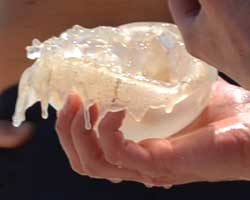 There are an abundance of jelly fish in our waters, most of which are not dangerous. They're in our waters year-round, with the high season being late summer or early fall, some of which travel in large schools. Swimmers usually get stung when they brush against the jellyfish. You can also get stung picking them up off the beach?the boy in the picture to the left picked up this jelly fish on Naples beach, hopefully he knew what kind it was. Most jelly fish with long tentacles sting, so stay out of the water to avoid stings when you see these jelly fish.
There are an abundance of jelly fish in our waters, most of which are not dangerous. They're in our waters year-round, with the high season being late summer or early fall, some of which travel in large schools. Swimmers usually get stung when they brush against the jellyfish. You can also get stung picking them up off the beach?the boy in the picture to the left picked up this jelly fish on Naples beach, hopefully he knew what kind it was. Most jelly fish with long tentacles sting, so stay out of the water to avoid stings when you see these jelly fish.
The Comb Jelly is the most common jelly fish in our waters and does not sting. It is a clear small jelly found drifting with the current.
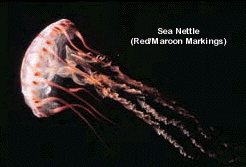 |
| Sea Nettle Jelly Fish Courtesy of NOAA |
Common local jelly fish you may encounter that STING are Moon jellies, Upside Down jelly, Sea Nettles, Cannonball jelly, and Portuguese man-of-war.
The Portuguese man-of-war is not a jelly fish but a unique species known as a siphonophore and is commonly encountered on the Atlantic beaches. If you see one, dead or alive, use extreme caution and stay away from them. The man-of-war has tentacles that can reach 50 feet that are lined with venom filled beads used to paralyze its prey. A sting by a Portuguese man-of-war can be excruciatingly painful but not fatal.
Cannonball jellies, pictured to the right, are the size of a large cantaloupe with short tentacles that contain a mild toxin. This large jelly fish is the least feared as most people are not bothered by their mild toxin.
Jelly fish stings can be painful and cause a rash. It is said the first 20 minutes after a sting are painful followed by another 20 minutes of itching. If you get stung, seek medical help especially if it is by a Portuguese man-of-war. If you choose to treat the stings yourself, carefully remove any tentacles on your skin with a stick or tweezers, then soak or rinse the area in vinegar for 15-30 minutes to stop the nematocysts from releasing their toxins. If you do not have vinegar available, rinse in sea water, isopropyl alcohol, or Safe Sea Jellyfish After Sting? pain relief gel (some say urinate on the sting, but I don't know about this one). Do not use fresh water which will cause the nematocysts to continue to release their toxin. Do not rub the area.
For more information visit this great webpage on Beach Hunter that describes in detail Florida jelly fish with excellent pictures is.
DISCLAIMER: We assume no responsibility for any harm due to the suggested treatment of stings by jelly fish. Following our suggested treatment is done at your own risk!
Sea Lice (Sea Louse)
 Sea Lice are Thimble Jellyfish larvae that show up in on lower Atlantic coast of Florida from March through August, with May and June their peak showing. Sea Lice microscopic and cause a itchy red rash on your skin when they become trapped inside your bathing suit. Other symptoms include fever, nausea, abdominal pain, and diarrhea. The itchy rash can last a few weeks but most last a few days. Treat Sea Lice stings the same as jelly fish, see above. Before swimming during peak months always check for warnings and posted signs to avoid getting stung.
Sea Lice are Thimble Jellyfish larvae that show up in on lower Atlantic coast of Florida from March through August, with May and June their peak showing. Sea Lice microscopic and cause a itchy red rash on your skin when they become trapped inside your bathing suit. Other symptoms include fever, nausea, abdominal pain, and diarrhea. The itchy rash can last a few weeks but most last a few days. Treat Sea Lice stings the same as jelly fish, see above. Before swimming during peak months always check for warnings and posted signs to avoid getting stung.
Sharks
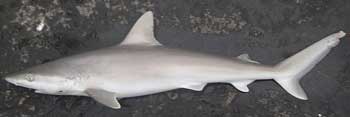
Sharks are everywhere in our waterways, mostly saltwater but sometimes brackish waterways. Sharks normally leave us humans alone, but sometimes they will accidently confuse you with dinner. Do not swim near schooling bait, this is the most common way that people have been bitten by sharks in our area. When fishing, do not bring a shark aboard unless you are certain how to handle it. Image Courtesy of NOAA.
Barracuda's
 Barracuda's are large saltwater fish found mostly offshore. It is common for them to come swimming along on top of the water near your boat while fishing. These fish are aggressive predators and can be dangerous. Barracuda's love shinny objects in the water and will go after a shinny lure, even jump out of the water after the lure as you reel it in. They are also opportunistic and will either steal your catch as you reel it in, or jump out of the water after your catch as you land it on your boat. Do not provoke them, they will come out of the water after you!
Barracuda's are large saltwater fish found mostly offshore. It is common for them to come swimming along on top of the water near your boat while fishing. These fish are aggressive predators and can be dangerous. Barracuda's love shinny objects in the water and will go after a shinny lure, even jump out of the water after the lure as you reel it in. They are also opportunistic and will either steal your catch as you reel it in, or jump out of the water after your catch as you land it on your boat. Do not provoke them, they will come out of the water after you!
Barnacles & Oysters
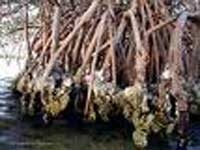 Oysters and barnacles are common on pilings, ladders in the water, boat bottoms, and mangrove roots. There are also oyster beds surrounding many mangrove islands. Oysters and barnacles have very sharp shells that can cause severe cuts. Avoid walking on them with bare feet or grabbing them with your hands. If you must handle them or walk on them wear shoes or gloves. Always look at the substrate when pulling up to unfamiliar mangrove islands to be sure you are not landing on an oyster bar which can damage your boat and cut your feet.
Oysters and barnacles are common on pilings, ladders in the water, boat bottoms, and mangrove roots. There are also oyster beds surrounding many mangrove islands. Oysters and barnacles have very sharp shells that can cause severe cuts. Avoid walking on them with bare feet or grabbing them with your hands. If you must handle them or walk on them wear shoes or gloves. Always look at the substrate when pulling up to unfamiliar mangrove islands to be sure you are not landing on an oyster bar which can damage your boat and cut your feet.
This information is provided only as a courtesy and there are NO guaranties, warranties, express or implied, or representations as to the accuracy of this content. Florida Go Fishing assumes NO liability or responsibility for any errors or omissions in the information contained here. If you find an error or omission in the data, please feel free to contact us with the correct information and we will verify and correct it as soon as possible.









